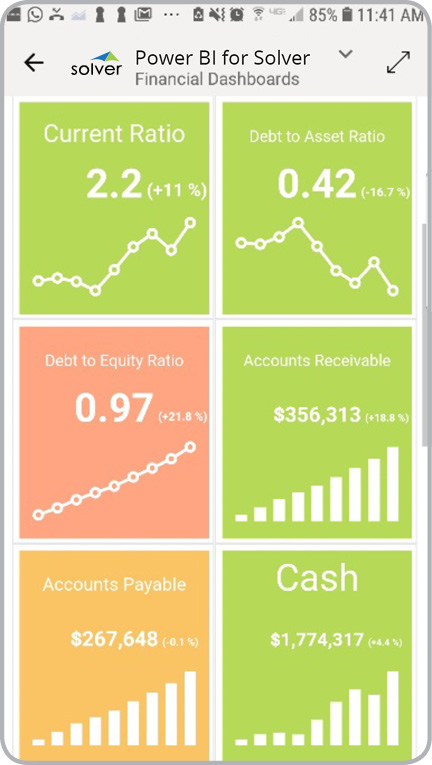Financial KPI Dashboard for Mobile Phones
What is a
Financial KPI Mobile App
? Mobile apps that display financial KPIs and charts are considered analytical apps and are used by executives and financial managers to view important metrics when they are on the go and not in front of their computer. Some of the main functionality in this type of mobile dashboard is that it displays financial figures and charts directly on mobile phones such as iPhones from Apple and Android-based phones like Samsung Galaxy. This particular dashboard shows six metrics: 1) Current ration, 2) Debt to asset ratio, 3) Debt to equity ratio, 4) Accounts receivable (AR), 5) Accounts payable (AP), and 6) Cash. You find an example of this type of mobile dashboard below.
Purpose of
Financial KPIs for Mobile Phones Companies use Financial KPIs for Mobile Phones to enable managers to monitor company performance when travelling or otherwise no in front of their computers. When used as part of good business practices in a Financial Planning & Analysis (FP&A) department, an organization can improve and speed up its decision-making, and it can reduce the chances that busy managers fall behind and lose track of important financial indicators.
Financial KPIs for Mobile Phone
Example Here is an example of a Financial KPI Dashboard for mobile phones. [caption id="" align="alignnone" width="432"]
 Financial KPI Dashboard for Mobile Phones[/caption] You can find hundreds of additional examples
here
Who Uses This Type of
Mobile dashboard
? The typical users of this type of mobile dashboard are: Executives and financial managers.
Other Reports Often Used in Conjunction with
Financial KPIs for Mobile Phones Progressive Financial Planning & Analysis (FP&A) departments sometimes use several different Key Performance Indicator (KPI) dashboards for mobile phones, along with balance sheet reports, monthly financial trend reports and other management and control tools.
Where Does the Data for Analysis Originate From? The Actual (historical transactions) data typically comes from enterprise resource planning (ERP) systems like: Microsoft Dynamics 365 (D365) Finance, Microsoft Dynamics 365 Business Central (D365 BC), Microsoft Dynamics AX, Microsoft Dynamics NAV, Microsoft Dynamics GP, Microsoft Dynamics SL, Sage Intacct, Sage 100, Sage 300, Sage 500, Sage X3, SAP Business One, SAP ByDesign, Acumatica, Netsuite and others. In analyses where budgets or forecasts are used, the planning data most often originates from in-house Excel spreadsheet models or from professional corporate performance management (CPM/EPM) solutions.
What Tools are Typically used for Reporting, Planning and Dashboards? Examples of business software used with the data and ERPs mentioned above are:
Financial KPI Dashboard for Mobile Phones[/caption] You can find hundreds of additional examples
here
Who Uses This Type of
Mobile dashboard
? The typical users of this type of mobile dashboard are: Executives and financial managers.
Other Reports Often Used in Conjunction with
Financial KPIs for Mobile Phones Progressive Financial Planning & Analysis (FP&A) departments sometimes use several different Key Performance Indicator (KPI) dashboards for mobile phones, along with balance sheet reports, monthly financial trend reports and other management and control tools.
Where Does the Data for Analysis Originate From? The Actual (historical transactions) data typically comes from enterprise resource planning (ERP) systems like: Microsoft Dynamics 365 (D365) Finance, Microsoft Dynamics 365 Business Central (D365 BC), Microsoft Dynamics AX, Microsoft Dynamics NAV, Microsoft Dynamics GP, Microsoft Dynamics SL, Sage Intacct, Sage 100, Sage 300, Sage 500, Sage X3, SAP Business One, SAP ByDesign, Acumatica, Netsuite and others. In analyses where budgets or forecasts are used, the planning data most often originates from in-house Excel spreadsheet models or from professional corporate performance management (CPM/EPM) solutions.
What Tools are Typically used for Reporting, Planning and Dashboards? Examples of business software used with the data and ERPs mentioned above are:
- Native ERP report writers and query tools
- Spreadsheets (for example Microsoft Excel)
- Corporate Performance Management (CPM) tools (for example Solver)
- Dashboards (for example Microsoft Power BI and Tableau)
Corporate Performance Management (CPM) Cloud Solutions and More Examples
February 24, 2021
TAGS:
Reporting,
Solver,
report writer,
Microsoft,
galaxy,
template,
cell phone,
practice,
Acumatica,
visualization,
Netsuite,
Finance,
planning,
GP,
dashboard,
graphical,
Business Central,
excel,
ax,
iPhone,
forecast,
Budget,
samsung,
Dynamics 365,
budgeting,
KPI,
Cloud,
Software,
Financial,
Tableau,
SAP,
example,
mobile,
best,
Sage,
BC,
D365,
NAV,
Intacct,
apple,
CPM,
report,
SL,
Management,
dynamics,
Power BI

